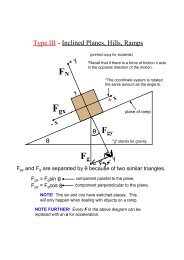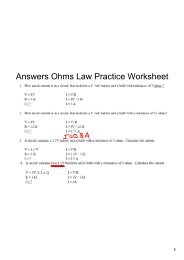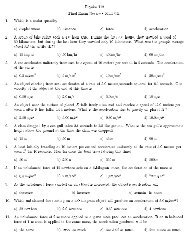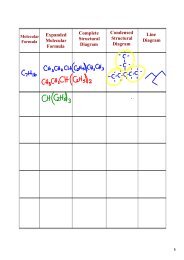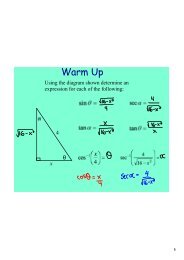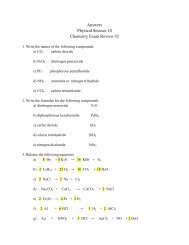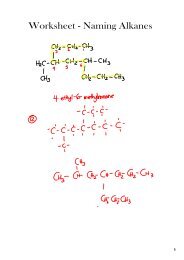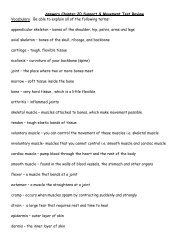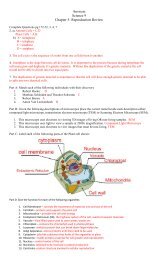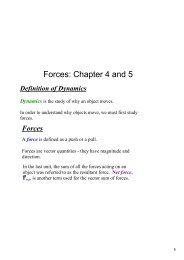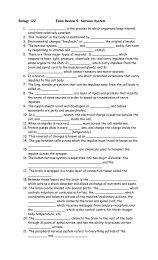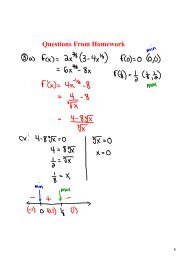Physics Study Guides.pdf - James M. Hill Memorial High School
Physics Study Guides.pdf - James M. Hill Memorial High School
Physics Study Guides.pdf - James M. Hill Memorial High School
You also want an ePaper? Increase the reach of your titles
YUMPU automatically turns print PDFs into web optimized ePapers that Google loves.
Newton’s LawsBig Picture<strong>Study</strong> <strong>Guides</strong>Newton’s laws form the basis for all of mechanics and describe the effects of forces on an object’s motion. Newton’slaws can be applied to all sorts of problems in mechanics and even some in electrostatics. Anytime a force is involved,Newton’s laws will determine the motion of the object the force is acting on.Key TermsInertia: An object’s resistance to changes in its motion.Force: Any push or pull. SI unit: NNormal Force (N): The reaction force exerted on anobject by the surface that is supporting it. SI unit: NFriction: The force that acts between moving materials.It always acts opposite the direction of the object’smotion or applied force (if the object isn’t moving).The frictional force f is proportional to the coefficientof friction μ, which depends on the surface the objectis moving over, and the normal force N. SI unit: NCoefficient of Static Friction: Coefficient of frictionused for objects at rest to determine how muchforce is required to make it begin moving.Coefficient of Kinetic Friction: Coefficient of frictionused for objects moving across a surface todetermine the force resisting the motion.Tension: Force on an object provided by a wire, string,cable, or similar object.<strong>Physics</strong>Disclaimer:Newton’s LawsNewton’s First LawKnown as law of inertia, it states that an object in motiontends to stay in motion and an object at rest tends tostay at rest unless acted on by an external force.• This means that an object moving with a constant velocity,speed, and direction will continue moving withthat velocity. An object that is not moving will notmove unless there a force acts on it.• The value of an object’s inertia can be measured.Mass is the measure of an object’s inertia while it isat rest.Newton’s Second LawExplains how the force acting on an object will affect itsmotion. The acceleration a (change in velocity) of anobject is directly proportional to the force F exerted on itand inversely proportional to the mass m (inertia) of theobject. F = maNewton’s Third LawThis law states that for any force exerted by one objecton another, the other object exerts an equal force in theopposite direction on the first object. For example, if aperson is pushing on a wall, the wall is also pushing backon them with an equal force in the opposite direction.• This law holds for all situations in which objects comeinto contact, even when the objects are accelerating.• While it seems like the third law would prevent theobject from moving because the reaction force wouldcancel the initial force, the two forces act on differentobjects so there is still a net force on the individualobjects.• Pairs of forces described by the third law must be: thesame type of force, exerted on two different objects,and equal in magnitude in opposite directions.• If there are multiple forces on the object, the accelerationis proportional to the net (overall) force.• Any net force causes an acceleration, but only forcesin the direction of motion causes a change in speed.• Forces applied perpendicular to direction of motionwill change the direction of motion, but not the speed.Free Body DiagramsThe forces on an object are often visualizedusing a free body diagram (FBD). FBDs areuseful for looking at the different types offorces acting on an object.Be careful when assigning signs. For each ofthe x- and y-components, remember whichdirection is positive and which is negative.Typically the “downward” direction is assignedas the negative direction, but you donot have to follow this convention as long asyour signs are consistent.Mass on a TableThis guide was created by Christopher Addiego and Catherine Wu. To learnmore about the student authors, visit http://www.ck12.org/about/about-us/team/interns.Gravity is a force that acts on all objects. Near thesurface of the Earth, the force due to gravity (F g )is equal to mg, where g is approximately 9.8 m/s 2 .• mg is what we call the weight of an object. It isnot the same thing as mass!Normal force (N) can be understood usingNewton’s third law. It is the force opposing gravityso that the net force on both objects (the massand the table) is zero. N = mgPage 1 of 3v1.1.10.2012this study guide was not created to replaceyour textbook and is for classroom or individual use only.




